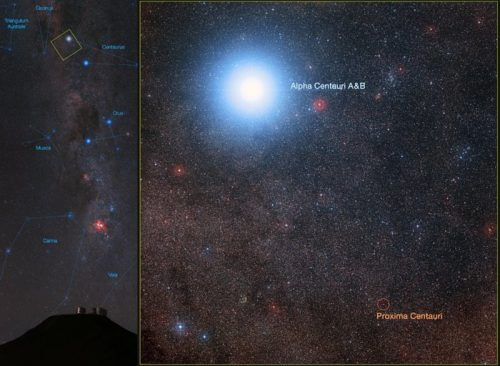Astronomers at the European Southern Observatory in Chile will look for planets near the Alpha Centauri star system. Such planets could be a target for launching tiny spacecraft through the Breakthrough Starshot initiative.

In the picture is the star system closest to the Sun - the double star Alpha Stanauri A and B and their distant companion - Proxima Centauri. At the end of 2016, the European Southern Observatory (ESO) signed an agreement with the Breakthrough Initiative to adapt the Very Large Telescope (VLT) instruments to search for planets in the Alpha Centauri system. These planets could be targets for the Breakthrough Starshot initiative to launch tiny spacecraft into this system. Photo:
ESO/B. Tafreshi (twanight.org)/Digitized Sky Survey 2 Acknowledgment: Davide De Martin/Mahdi Zamani
The European Southern Observatory (ESO) has signed an agreement with the Breakthrough Initiative to adapt the Very Large Telescope (VLT) instruments to search for planets in the Alpha Centauri system. These planets could be targets for the Starshot Breakthrough initiative to launch tiny spacecraft into this system.
ESO represented by CEO Tim de Zeeuw signed the agreement with Pete Worden, director of the Breakthrough Fund.
The venture provides funding for an instrument called VISIR (VLT Imager and Spectrometer for mid-Infrared) that will be mounted on the European Southern Observatory's Very Large Telescope (VLT) in order to enhance the telescope's ability to search for habitable planets around Alpha Centauri, the closest solar system to Earth that is mostly visible from the sky the southern hemisphere. The agreement will allow the foundation to get observing time to carefully search for the planets starting in 2019.
The 2016 discovery of a planet, Proxima b around Proxima Centauri – the third and faintest of the stars in the Alpha Centauri system, gave further impetus to the search.
Knowing where the nearest planets are is of paramount importance to the Breakthrough Starshot project, a research and engineering program launched in April 2016 that aims to prove the concept of ultrafast laser-guided tiny spacecraft for the first launch of such spacecraft that could reach Alpha Centauri within a generation.
Discovering a habitable planet is a huge challenge due to the brightness of the star it orbits, which tends to overwhelm the relatively dim planet. One way to facilitate detection is to observe the system in the mid-infrared wavelength range, where the thermal glow emitted by an orbiting planet reduces the brightness gap between it and the star. But even in the mid-infrared range, the star is still too bright than the other planets to be detected, so a dedicated technique has been developed to reduce the glare.
The VISIR device that will be installed on the VLT will be able to significantly improve the image quality through adaptive optics, using a technology called coronagraphy that reduces the starlight and thus reveals the possible signal of the potential planets. The Breakthrough Starshot initiative will pay for much of the development costs of these technologies and ESO will provide long-duration observing capabilities.
A statement released by the European Southern Observatory said that identifying and studying potentially habitable planets orbiting other stars will be one of the main scientific goals of the next European Large Telescope (E-ELT). Although the increased size of the E-ELT will be essential for imaging a planet at greater distances to the Milky Way, the light-gathering power of the VLT only allows for observations of planets around the nearest star Alpha Centauri.
The developments that will be carried out for VISIR can also be useful for the METIS device that will be installed on top of the E-ELT, this is in addition to the accumulated knowledge and the software that can be transferred directly. The enormous size of the E-ELT should allow METIS to detect and study Mars-sized planets orbiting Alpha Centauri, if they exist, as well as potentially habitable planets around other nearby stars.
For a message from the Southern European Observatory
https://www.sciencedaily.com/releases/2017/01/170112130736.htm
